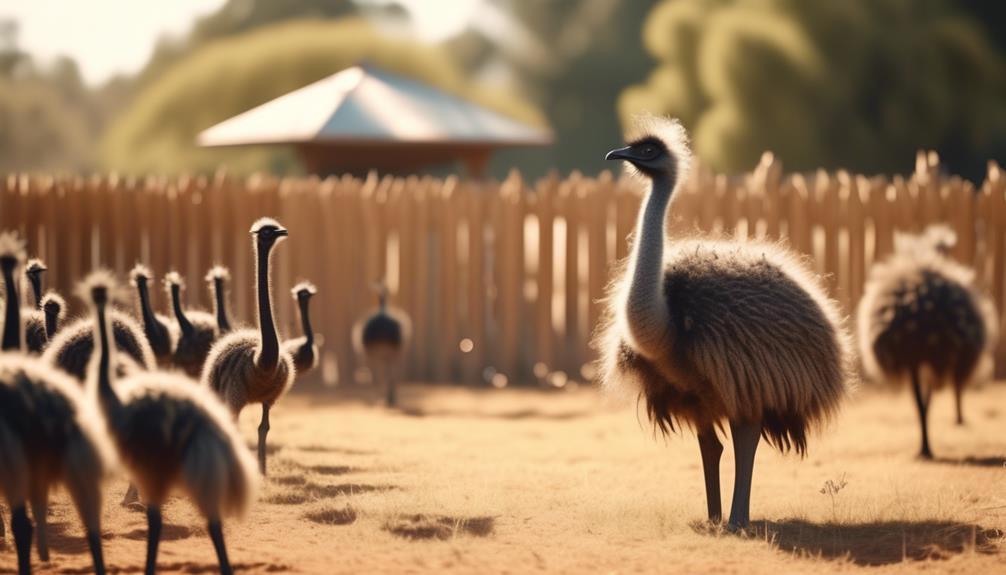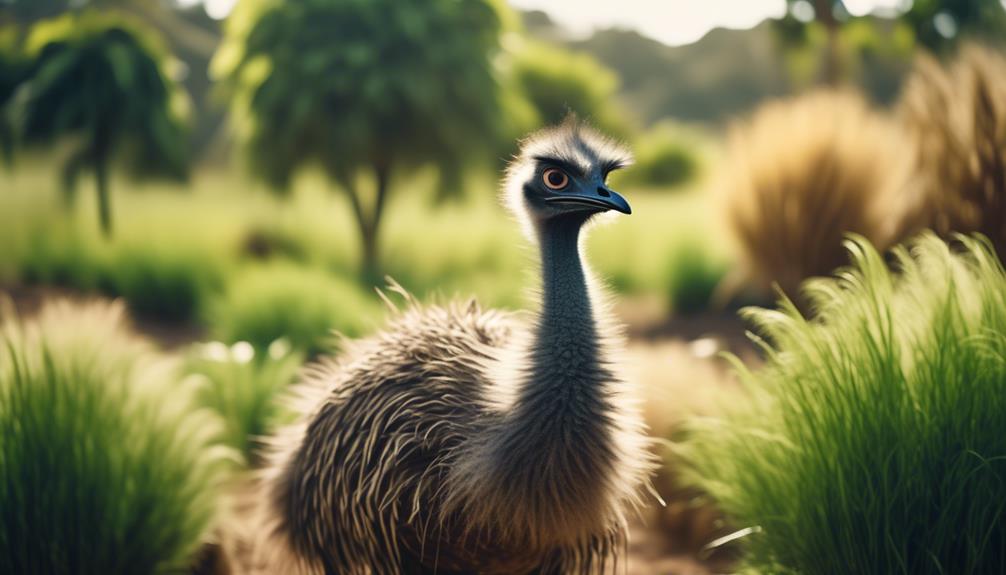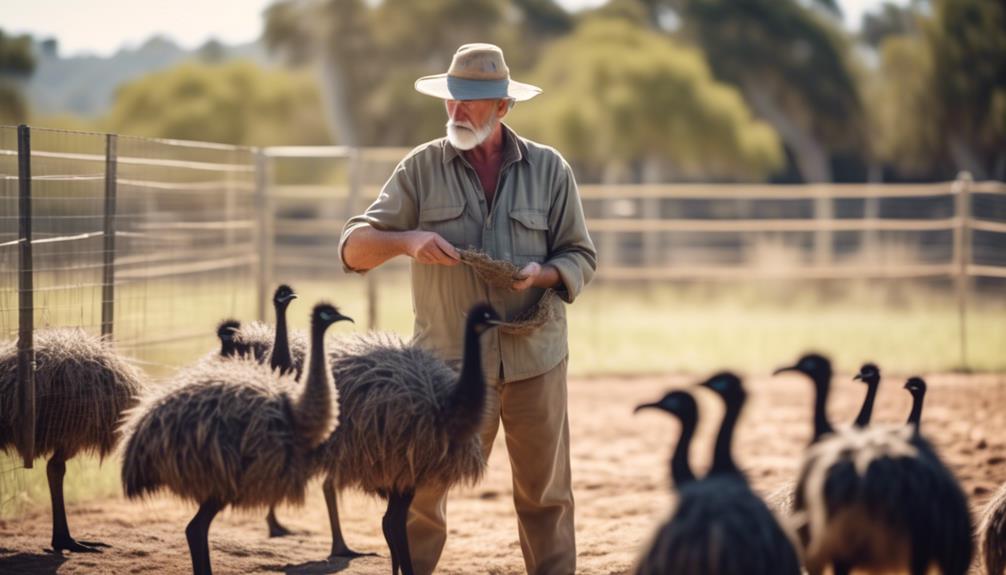
As the sun begins to rise on the horizon, signaling the approach of emu breeding season, it's time to prepare for the intricate dance of nature that lies ahead. With feathers gently rustling in the breeze and hearts beating in anticipation, you stand at the precipice of a world filled with possibilities.
But how can you ensure success in this delicate endeavor? Fear not, for within these pages, you will uncover essential tips that will guide you through the enchanting journey of emu breeding season.
So, gather your patience and curiosity, for a world of emu romance awaits.
Key Takeaways
- Emus mate with multiple females during the breeding season, which typically occurs from November to April.
- Providing a suitable breeding environment includes ample space for courtship behaviors, maintaining a temperature range of 50°F to 80°F, offering a balanced diet, ensuring access to fresh water, and minimizing disturbances and predators.
- Adequate nutrition for breeding emus involves offering a variety of food sources, providing fresh water at all times, considering nutritional supplements, and monitoring body condition.
- Recognizing the signs of mating behavior includes observing the unique dance, vocalizations, nesting behavior, and potential aggression of male and female emus.
Understanding Emu Breeding Cycles
To understand Emu breeding cycles, it's important to delve into the intricate details of their reproductive patterns and behaviors. Emus are large flightless birds native to Australia. They've unique breeding habits that are influenced by their reproductive system.
Emus are polygamous creatures, meaning that males mate with multiple females during the breeding season, which typically occurs from November to April. During this time, male Emus become more aggressive and territorial, engaging in elaborate courtship displays to attract a mate.
The Emu reproductive system is fascinating. Females possess a single functional ovary, while males have two testes. When a male successfully attracts a female, he'll mount her and deposit his sperm into her cloaca. The cloaca is a multipurpose opening used for both reproduction and waste elimination.
After mating, the female will lay a clutch of around 5 to 15 large eggs, which she'll incubate for approximately 56 days. It's interesting to note that once the female lays her eggs, she leaves the incubation and care of the eggs to the male. The male Emu takes on the responsibility of incubating the eggs and raising the chicks.
Understanding these Emu breeding habits and the intricacies of their reproductive system is essential for successful breeding and conservation efforts. By respecting their natural behaviors and providing appropriate care, we can ensure the continued health and viability of the Emu population.
Establishing a Suitable Breeding Environment
When establishing breeding grounds for Emus, it's essential to create optimal conditions that promote successful breeding. Firstly, ensure that the habitat provides ample space for the Emus to move around and engage in courtship behaviors. Emus require open areas with minimal obstructions, such as trees or dense vegetation.
Additionally, it's crucial to maintain a suitable temperature range for breeding. Emus thrive in environments with temperatures between 50°F and 80°F (10°C to 27°C). Adequate shelter should also be provided to protect the Emus from extreme weather conditions.
Furthermore, the breeding environment should offer a balanced diet for the Emus. Ensure that there's a variety of vegetation, seeds, and insects available for the birds to forage. The availability of water sources is equally important, as Emus require regular access to fresh water for drinking and bathing.
To establish a successful breeding environment, it's vital to minimize disturbances and predators. Fencing the breeding area and implementing security measures can help protect the Emus and their eggs from predators.
Providing Adequate Nutrition for Breeding Emus

When ensuring the optimal breeding environment for Emus, it's crucial to provide them with a well-balanced and nutritious diet. Meeting their feeding requirements is essential for their reproductive success. Emus are herbivores, and their diet primarily consists of plants, fruits, vegetables, and grains. To ensure their nutritional needs are met, it's recommended to offer a variety of food sources, including grasses, leafy greens, and seeds. Providing fresh, clean water at all times is also vital for their overall health.
In addition to their regular diet, nutritional supplements can be beneficial during the breeding season. Supplements such as calcium, phosphorus, and vitamins can help support their reproductive health. Calcium is particularly important for egg development and muscle function. It can be provided through calcium-rich sources like crushed eggshells or commercially available calcium supplements.
To maintain intimacy with your breeding Emus, it's crucial to monitor their body condition and adjust their diet accordingly. Emus in breeding season may require additional feeding to meet their increased energy demands. Regularly assess their weight, muscle tone, and overall health to ensure they're receiving the appropriate nutrition.
Recognizing the Signs of Mating Behavior
Breeding Emus exhibit specific behaviors that indicate they're ready to mate. If you're an emu breeder, it's crucial for you to be able to identify courtship rituals and manage aggressive behavior during the mating season. Here are some key signs to look out for:
- Dancing: Male emus perform a unique dance during courtship, which involves stretching their necks, puffing up their feathers, and swaying from side to side. This behavior is a clear indication that they're seeking a mate.
- Vocalizations: Both male and female emus make distinct sounds during the breeding season. Males emit a deep booming call, while females respond with a soft drumming sound. Pay attention to these vocalizations as they're an essential part of the mating process.
- Nesting behavior: Female emus will start preparing their nests by scraping out a shallow depression in the ground. They may also gather leaves and twigs to line the nest. Observing this behavior can help you determine if a female is ready to mate.
- Aggression: During breeding season, male emus can become territorial and aggressive towards other males. They may display aggressive behaviors such as pecking, charging, or neck wrestling. It's important to manage any aggressive behavior to ensure the safety of both the emus and the breeders.
Ensuring Proper Nesting Areas for Emus

To ensure successful breeding and nesting, it's essential for emu breeders to create suitable nesting areas for their emus. Understanding emu nesting habits is crucial in providing the ideal conditions for their reproduction. Emus typically build their nests on the ground, preferably in dry areas with good visibility. They prefer locations with a slight incline, such as sandy or gravelly soil, which allows for better drainage and reduces the risk of flooding.
Creating ideal nesting conditions starts with preparing the nesting site. Clear any debris or vegetation that may hinder the emus from constructing their nests. It's advisable to provide a designated area for nesting, with ample space to accommodate multiple nests. Emus are communal nesters, and having enough room ensures that each pair can establish their own territory.
To mimic the natural nesting environment, emu breeders can provide suitable nesting materials. Emus prefer to use soft, fibrous materials like grass, leaves, and twigs to construct their nests. Supplying these materials in abundance will encourage the emus to build sturdy and protective nests.
Managing Emu Breeding Pairs
Managing emu breeding pairs requires careful selection and monitoring to ensure optimal reproductive success. Emus are fascinating creatures with unique mating rituals and strong pair bonding instincts.
To effectively manage emu breeding pairs, keep the following tips in mind:
- Selective Pairing: When selecting emus for breeding, consider their genetic diversity and health. Choose pairs that are compatible in terms of size, age, and temperament.
- Monitoring Behavior: Observe the emus closely during the breeding season. Look for signs of courtship, such as vocalizations, head bobbing, and the male puffing up his feathers. These behaviors indicate that the pair is forming a bond.
- Providing Adequate Space: Emus need ample space to perform their mating rituals and establish their territory. Ensure that each pair has enough room to move around comfortably and engage in courtship displays.
- Nesting Areas: Create suitable nesting areas for the emu pairs. Provide soft bedding material, such as straw or hay, and ensure that the area is secluded and protected from predators.
Addressing Potential Breeding Challenges

As you focus on the management of emu breeding pairs, it is important to be prepared for potential challenges that may arise during the breeding season. Breeding challenges can hinder successful reproduction and impact the overall productivity of your emu farm. However, with proper planning and proactive measures, you can overcome these obstacles and maximize breeding success.
To help you address potential breeding challenges, here are some common issues you may encounter and practical solutions to overcome them:
| Potential Breeding Challenges | Solutions |
| —————————- | ——— |
| Low fertility rates | – Ensure proper nutrition and a balanced diet for breeding pairs
- Conduct regular health checks and address any underlying health issues
- Consider artificial insemination if fertility rates remain low |
| Aggression between breeding pairs | – Provide ample space and separate aggressive individuals if necessary
- Implement a gradual introduction process to reduce stress
- Monitor pair dynamics and intervene if necessary |
| Nest abandonment | – Provide suitable nesting materials and create a safe and comfortable environment
- Monitor nests closely and address any disturbances or predators
- Consider using artificial incubation techniques if nest abandonment persists |
Monitoring and Caring for Emu Eggs
Monitor the development and well-being of emu eggs closely to ensure optimal conditions for successful hatching. Emu egg incubation is a delicate process that requires careful attention and precise monitoring. Here are some essential tips to help you in monitoring and caring for emu eggs:
- Maintain proper temperature: Emu eggs require a constant temperature of around 97°F (36°C) for successful incubation. Use a reliable thermometer to monitor and adjust the temperature as needed.
- Control humidity levels: Emu eggs require a specific level of humidity for proper development. Aim for a humidity level of around 40-50% during the incubation period. Regularly check and adjust humidity levels using a hygrometer.
- Regularly rotate the eggs: Emu eggs should be rotated gently at least three times a day to prevent the embryo from sticking to the shell and promote even heat distribution. Use caution and avoid excessive movement that could harm the developing embryo.
- Observe egg candling: Candling is the process of shining a light through the egg to observe the development of the embryo. This can help you identify any potential issues or abnormalities early on.
Emu chick development is a fascinating process, and by closely monitoring and caring for the eggs during incubation, you can increase the chances of successful hatching. Remember to provide a warm, humid environment and regularly rotate the eggs to ensure optimal conditions for the developing emu chicks. Stay vigilant and attentive to promote healthy growth and a successful outcome.
Frequently Asked Questions
How Long Does the Emu Breeding Season Typically Last?
The emu breeding season typically lasts for several months. Environmental factors, such as temperature and rainfall, can influence the duration. It is important to understand these effects to effectively prepare for the breeding season.
Can Emus Breed All Year Round, or Only During a Specific Time of the Year?
Emus can only breed during a specific time of the year, known as the emu breeding season. Factors such as temperature and daylight length play a crucial role in determining the timing of this season.
What Are Some Common Mistakes to Avoid When Establishing a Breeding Environment for Emus?
When establishing a breeding environment for emus, avoid common mistakes like inadequate space, improper temperature control, and insufficient nesting materials. Remember, emus can breed year-round, so ensure a suitable environment for their breeding season duration.
How Can I Ensure That My Emus Are Receiving the Right Nutrition for Successful Breeding?
To ensure successful emu breeding, make sure your emus receive the right nutrition. Properly balanced diets, including quality protein sources and essential vitamins and minerals, are key factors for breeding success.
Are There Any Specific Behaviors or Physical Changes That Indicate an Emu Is Ready to Mate?
To determine if an emu is ready to mate, observe their behavior and physical changes. Look for signs like increased vocalization, tail wagging, and the male's drumming. These indicate their mating readiness.
Conclusion
You now have the essential knowledge and tips to successfully prepare for emu breeding season.
By understanding their breeding cycles, creating a suitable environment, providing proper nutrition, recognizing mating behavior, ensuring nesting areas, and managing breeding pairs, you can increase your chances of successful breeding.
Remember, while challenges may arise, with careful monitoring and care for the eggs, you can overcome them and enjoy a rewarding emu breeding experience.
So, get ready to embark on this exciting journey with confidence!




